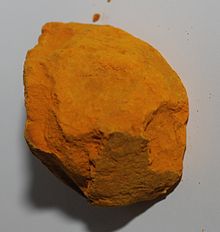Euxanthinic acid
| Structural formula | |||||||||||||
|---|---|---|---|---|---|---|---|---|---|---|---|---|---|

|
|||||||||||||
| General | |||||||||||||
| Surname | Euxanthinic acid | ||||||||||||
| other names |
|
||||||||||||
| Molecular formula | C 19 H 16 O 10 | ||||||||||||
| External identifiers / databases | |||||||||||||
|
|||||||||||||
| properties | |||||||||||||
| Molar mass | 404.33 g mol −1 | ||||||||||||
| safety instructions | |||||||||||||
|
|||||||||||||
| As far as possible and customary, SI units are used. Unless otherwise noted, the data given apply to standard conditions . | |||||||||||||

Euxanthin acid is a chemical compound from the group of xanthine glucuronosides . The calcium / magnesium salt of euxanthic acid is called Indian yellow and is a natural dye that has been used in South Asian painting for centuries . Chemically it is a lacquered xanthene glucoronoside. The dye is no longer on the market.
Origin and extraction
Real Indian yellow is a product of animal metabolism. It was obtained from the urine of Indian cows . These were fed with mango tree leaves ( Mangifera indica , Anacardiaceae) with reduced fluid intake . Due to pathological metabolic processes and a lack of nutrients, the animals excreted an intensely colored urine . This was concentrated by heating, with the yellow dye separating out. This was pressed and formed into balls. The Indian yellow came into the trade from East India in the form of large spheres, the so-called piuri ( bengali : পিউরি ). The yield was about 50 g piuri per day per cow.
In the late nineteenth century, orders from the Indian administration prohibited cows from being fed mango leaves. At the beginning of the 20th century, the dye disappeared from the market for reasons of animal welfare.
Ingredients from Piuri
The Indian yellow dye is a magnesium / calcium color lacquer of euxanthic acid. Euxanthic acid is a glycoside of glucuronic acid and euxanthone (1,7-dihydroxy-9 H -xanthen-9-one). It therefore belongs to the series of xanthene dyes . Good Piuri qualities contained ≈65% color varnish, poor only ≈35%. The hydrolyzate euxanthone was predominantly in poor quality.
use
The real Indian yellow was historically used primarily as a watercolor paint ; But it was also used in oil painting as a glaze paint . It was a popular yellow pigment in fine art painting in India during the Mughal period (16th to 19th centuries). Significant quantities were exported to Europe; however, there are few sources for its use in European art painting. It was first detected in Vermeer's " Woman with Scales ". In contrast, Indian yellow could be detected on many Asian paper paintings from the period mentioned.
proof
The simplest indication of the use of Indian yellow is obtained by looking at the art object in UV light. When excited with long-wave UV light (365 nm), it shows an intense yellow fluorescence. This proved the use of Indian yellow in shades of yellow, green and orange in South Asian, especially Indian, miniature paintings from before and around 1900. This typical fluorescence is missing in more recent miniatures. A further indication can be obtained by detecting the Mg 2+ with quinalizarin (detection limit <1 ng). Reliable evidence is provided by means of IR spectroscopy .
Coloristics
Indian yellow produces a dark, deep and warm reddish yellow . The original sound can not be displayed due to the high color saturation in the monitor gamut . It is more reddish than the natural sienna , but much deeper in color , when applied thickly, it looks brownish . The hue is between buttercups yellow and saffron yellow.
Substitute dyes
Today the real Indian yellow has been largely replaced by synthetic dyes from the group of azo dyes / Indanthrene yellow ® from BASF or by cobalt yellow (see potassium hexanitrocobaltate). A natural source of a dye of the appropriate shade is the luteolin- containing dye plant Wau ( Reseda luteola ).
False Indian yellow
A nitration product of tropaeolin is known as false Indian yellow .
literature
- Kurt Wehlte : Materials and techniques of painting. Otto Maier Verlag, Ravensburg 1990, ISBN 3-473-48359-1 (formerly: ISBN 3-473-61157-3 )
- Helmut Schweppe: Handbook of natural dyes. Nikol Verlagsgesellschaft, Hamburg 1993, ISBN 3-933203-46-5 .
- Nicholas Eastaugh: Pigment Compendium: A Dictionary of Historical Pigments . Butterworth-Heinemann , 2004, ISBN 0-7506-5749-9 .
- John Stenhouse: Examination of a yellow substance from India called Purree ... . In: The London, Edinburgh and Dublin Philosophical Magazine and Journal of Science . November 1844, pp. 321-325.
- MJFL Merimee: The Art of Painting in Oil and Fresco . Kessinger Publishing, 8/5/2009, ISBN 978-1-4371-4116-0 , p. 109.
Individual evidence
- ↑ This substance has either not yet been classified with regard to its hazardousness or a reliable and citable source has not yet been found.
- ↑ Winsor & Newton Newsletter 2/2001.
- ↑ a b c d N. S. Baer, A. Joel, RL Feller, N. Indicator: Indian Yellow. In: RL Feller (Ed.): Artists Pigments (A Handbook of their History and Characteristics). Vol. 1 1986, pp. 17-36.
- ↑ Wehlte points out that the collection at the Institute for Painting Technology in Stuttgart contains original samples of Piuri and pigment.
- ↑ Chapter 3: “un petit pan de mur jaune”: A short story in research (Proust). P. 137.
- ↑ RGB (247, 182, 0) - color sample according to H. Schmincke & Co .: color 220 Indian yellow ( Memento from February 14, 2008 in the Internet Archive )
- ↑ Entry on Indian yellow. In: Römpp Online . Georg Thieme Verlag, accessed on February 13, 2013.
